|
|
| 'Like' us on Facebook | Follow us: |
Posted on: July 18, 2016
SERVICE TO MAN IS SERVICE TO GOD
The story of how Swami Karunyananda
came to live with Bhagawan Sri Sathya Sai Baba
- Part 2
Swami Karunyananda is perhaps the only person who came to Swami as a 60 year old and still managed to stay with Him and serve Him for four decades! A common sight for the regular Puttaparthi visitor in the 1970s, 1980s and 1990s, Swami Karunyananda happily gave up an entire service organisation he had started from scratch in order to find ultimate fulfilment of his life. From walking behind Bhagawan holding an umbrella to holding the empty pot from which Baba manifested vibhuti galore; from staying with Swami to travelling with Him to distant places - Karunyananda was blessed with it all. His is a story extraordinaire of a man’s passion for service and God’s appreciation of it.
When we are evaluating a company, more often than not, we look at the present circumstances and decide whether it is good or not. If it isn’t doing well today, it is a bad company; if it is doing well, it’s a good one. There are a few people however, who are able to study the company by going into its past and then, they predict its future trajectory. These are investors and they benefit by association with the company. Any good company has its share of ups and downs and the wise investor always studies good companies. So too, if we want to be wise investors in the business of life, we not only need to keep good ‘company’ of noble people but also ‘study’ the timelines of these noble ones!
Anyone who would have seen or come to know of Swami Karunyananda in the 1980s and 1990s would have thought that he is one hell of a lucky person. It is only the ‘spiritual investors’ who would benefit by looking beyond at his past to study and understand his life. Yes, Karunyananda was a blessed soul because he was born with virtues of compassion and caring. He was also blessed to get a virtuous being as his mother. That was destiny. But that does not mean he didn’t have to slog and toil hard to get a permanent place in Swami’s heart and Prasanthi Nilayam. His sincerity, determination and efforts are worthy of emulation.
Venkatasubbiah to Bala Subbaramadas through Bhakti
He was born as Venkatasubbiah at 4:30 am on 10th October 1894 in Athimanjeripeta (in current day Tiruttani taluk of Tiruvallur district, Tamil Nadu) to parents Subbulakshmamma and Venkatappa Naidu. Subbulakshmamma was a doting mother who instilled love and forbearance in the lad as we read in the first part. However, when Venkatasubbiah was about seven years old, his mother passed away. Unable to tend for the little child amidst his travelling and work, the father gave him into the care of the Karnam (Government clerk during the British times) of Pennalurpeta, Venkatarayudu. This Venkatarayudu and his wife treated the boy more like a slave than a son. Thus, he had to do all the household chores even though he was barely a 10 year old. But the little lad did not wince even a bit.
He remembered his mother’s words in those trying situations.
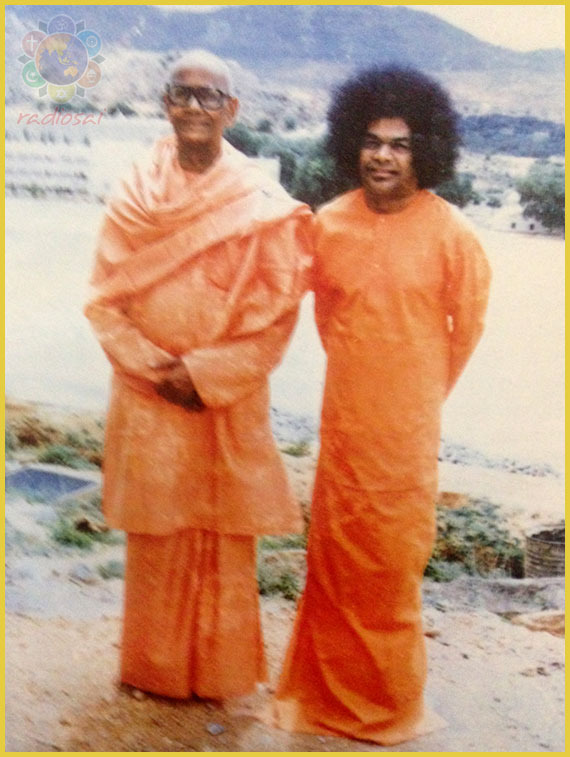 |
“Every time we feel that we are being beaten, remember the Dhobi (washerman) pounding the clothes on a rock. The clothes are trashed but they are actually being cleaned. Hardships cleanse us.”
Deriving strength from those words, he dutifully went about doing everything with a smile. Destiny however, seemed to conspire with misfortune for Venkatasubbiah. Even as he began primary education at Thiruvalangadu at the home of the Karnam’s relative, his father expired! Though this was a devastating blow, Venkatasubbiah used this as another excuse to turn inwards.
From that day on Venkatasubbiah would complete all his duties and responsibilities at school and home and rush to some Satsangh or Bhajan session. He would keep company of the Sadhus and saints as much as possible, thinking of God. He was particularly regular in the service of ‘Mouni Swami’, a sadhu who had taken to the observance of silence. Venkatasubbiah learned that silencing the mouth is the first step in silencing the senses and the mind. On the rare occasions when Mouni Swami dispensed with his silence to speak on Vedanta, Venkatasubbiah was always there, drinking deep into the wisdom. At other times, the lad absorbed himself in the songs of Bhadrachala Ramadas. Such was his flair for service, spiritual knowledge and singing that the elders soon began to call him as Bala Subbaramadas (meaning ‘Subba, the young Ramadas’).
Swami Karunyananda is born
When Balasubba Ramadas heard about the sage of Thiruvannamalai, Sri Ramana Maharshi and a longing to meet him grew. Thus, in 1914, he travelled further south to the Virupaksha cave in the Arunachala hills and prostrated at the feet of Ramana Maharshi.
“Revered one, please teach me the Spiritual Truth.”
“Child, start making efforts to find the answer to one question - Who Am I. Ask yourself that and find its answer.”
The lad did not understand the significance of the message. Nor did he get inspired by it. But he felt thrilled just to be in the presence of the master and in the temple at Thiruvannamalai. So, he continued his life here, serving the holy ones and sustaining himself on the Prasadam at the temple. It is indeed amazing how a man seeking spiritual riches can make do with the most meagre of worldly wealth!
Many months passed this way. This was the time when World War I was in full swing and the British Government in India was forcing all able-bodied men into the army. Subbaramadas (the prefix ‘Bala’ was dropped since he was in his youth now) was remanded with a view to deport him to the war zone. Subbaramadas pleaded with them,
“I am committed to Ahimsa (non-violence). You may send me with a gun to the battlelines. But know for sure I will not harm any being. I will die if I am shot and the loss of a soldier and his equipment will be all yours. I assure you that I'm on a spiritual path and am of no use to you or your government.”
Call it the power of speaking the truth or the impact of an aspirant’s determination, it worked! “Leave this place or you will be caught again”, the policemen said as they let him go.
When one seeks in all humility and genuineness, the Lord always responds. When Subbaramadas was wondering where he would go to, he got the ‘acquaintance’ of Palani Swamy who told him,
“This is not a proper place for you. If you want to progress, go to Tirumala. In the hills there, at Gogarbha, is a great soul who is meant to show you the path to tread.”
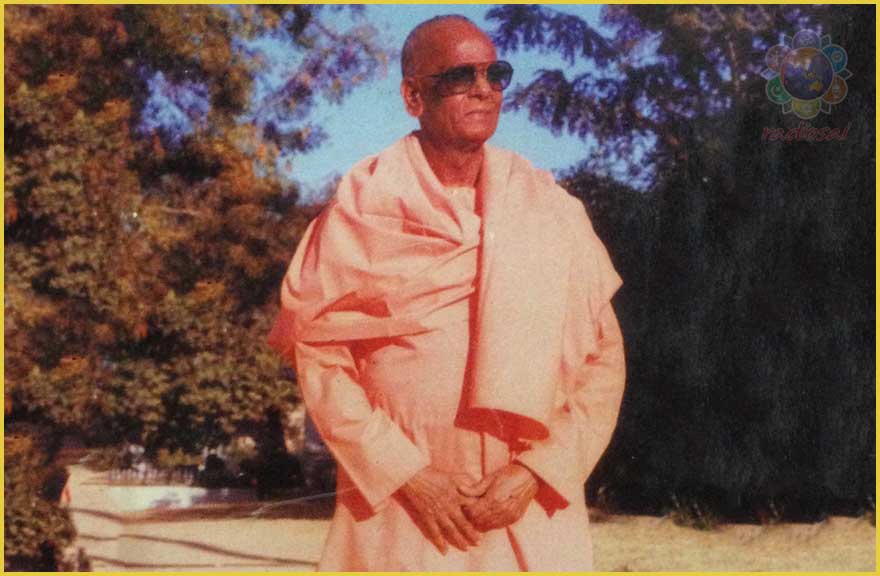 |
That was how Karunyananda met his mentor and Guru - Sri Malayala Swami. He stayed with him for several days, yearning and learning. He sold the silver waistband in order to get money to fulfil his paltry material needs. The time spent here saw Subbaramadas grow in wisdom to complement his devotion. Realizing the futility of a worldly life, he sought the Sanyasa Deeksha (initiation into the life of a complete renunciant) from Malayala Swami.
“My child, I have not taken the Sanyasa Deeksha myself and so it is not right for me to confer it on you. You should go meet Swami Sivananda in Rishikesh and get the Deeksha from him.”
“As you wish master”, Subbaramadas replied, “but please suggest the name I should choose when asked for...”
“You have a lot of compassion for living beings since childhood. So choose the name Karunyananda.”
Thus it was that Subbaramadas was initiated into Sanyasa by Swami Sivananda at Rishikesh and he came to be known by the name - Swami Karunyananda.
Bhakti and Jnana need Karma to supplement
The Sanyasa Ashrama is the final stage of life as per the Ashrama Dharma.
| Ashram or stage | Age (approx) |
Description |
| Brahmacharya (student life) |
Till 24 | Brahmacharya represented the bachelor student stage of life. This stage focused on education and included the practice of celibacy. The student went to a Gurukul (house of the guru) and typically would live with a Guru (teacher), acquiring knowledge of science, philosophy, scriptures and logic, practicing self-discipline, working to earn dakshina to be paid for the guru, learning to live a life of Dharma (righteousness, morals, duties). |
| Grihastha (household life) |
24-48 | This stage referred to the individual's married life, with the duties of maintaining a household, raising a family, educating one's children, and leading a family-centred and a dharmic social life. Grihastha stage was considered as the most important of all stages in sociological context, as human beings in this stage not only pursued a virtuous life, they produced food and wealth that sustained people in other stages of life, as well as the offsprings that continued mankind. The stage also represented one where the most intense physical, sexual, emotional, occupational, social and material attachments exist in a human being's life. |
Vanaprastha (retired life) |
48-72 | The retirement stage, where a person handed over household responsibilities to the next generation, took an advisory role, and gradually withdrew from the world. Vanaprastha stage was a transition phase from a householder's life with its greater emphasis on Artha and Kama (wealth, security, pleasure and sexual pursuits) to one with greater emphasis on Moksha (spiritual liberation). |
| Sanyasa (renounced life) |
72+ (or any time) |
The stage was marked by renunciation of material desires and prejudices, represented by a state of disinterest and detachment from material life, generally without any meaningful property or home (Ascetic), and focussed on Moksha, peace and simple spiritual life. Anyone could enter this stage after completing the Brahmacharya stage of life. |
It is often thought that Sanyasa is the renunciation of all responsibilities. It is actually the other way. In Brahmacharya, one is responsible only for oneself. In Grihastha, the responsibilities increase and one has to think of family and society. In Vanaprastha, one has to be more broad-based and take up responsibility for all the beings in the world. The Sanyasi has the maximum responsibilities because his life is no longer his; it is God’s!
 |
Swami Karunyananda understood this when he met Mahatma Gandhi at Rishikesh in 1933. Gandhiji arrived before time for the public meeting and took his place on the dais. He observed that a lot of sadhus and sanyasis had also gathered in the assembly. He began his address with a question,
“The mere presence of so many Sanyasis evokes joy in me. I want to know what you all are doing here...”
“We are here for lifelong Tapas (penance)”, a sadhu replied.
“What is Tapas?” asked Gandhiji.
Seeing no answer forthcoming, he answered with a discourse,
“Embodiments of the Atma! Tapas is not leaving responsibilities and meditating. Not confining the use of the physical body for selfish interests and making it useful for others is Tapas. In spite of having great wealth, Bharat is suffering under foreign rule. It is only when our people engage in selfless service that our country can get back its original high stature.
I humbly request you to engage in selfless service for the benefit of community. Selfless service is the surest path to realization of God. That is true Tapas. Sadhus! You have dedicated your hearts to God. Service to man is service to God. Are we all ready?”
In response, only one hand went up in the audience. It was Karunyananda!
“I wholeheartedly offer myself to the service of mankind today...”
Gandhiji was impressed. He got the details of Swami Karunyananda. After this, several others also raised their hand in dedication to the service of mankind. Inspiration is contagious indeed!
Later, Karunyananda wrote a letter to Gandhiji seeking his blessings. The reply he got touched him,
“If you follow the Truth without lapse, that itself will bless you and protect you for there is no God higher than Truth.”
Charged up with inspiration and compassion, Swami Karunyananda returned to Samalkota town (also called Samarlakota) in East Godavari region. He began working in right earnest for the service of society. The result of his efforts was the establishment of the Jeeva Karunya Sangam in 1935. Since this was during the ghastly 2nd World War, the Sangam had multiple noble objectives as listed below:
• Propagation of Non-Violence (Ahimsa)
• Uplift of Harijans (the outcastes in society)
• Free medical aid and health education.
• Refuge for the aged, diseased and orphaned.
• Supplying milk to undernourished children
• Cremation of unclaimed corpses
• Free food for the Disabled
• Helping Children - supplying milk, educational aid, adoption and finding homes for children lost during the war.
• Helping families in Distress
• Service to Lepers
• To rush to the aid of peoples affected by natural calamities, such as cyclones, fires, accidents, etc.
• Adult Education
• Imparting Spiritual Knowledge
The activities of the Sangam grew at such a pace that it got headquartered at Rajahmundry in 1940 and continued its sterling service for decades. Now, is it any wonder that Karunyananda found a place in Swami’s heart?
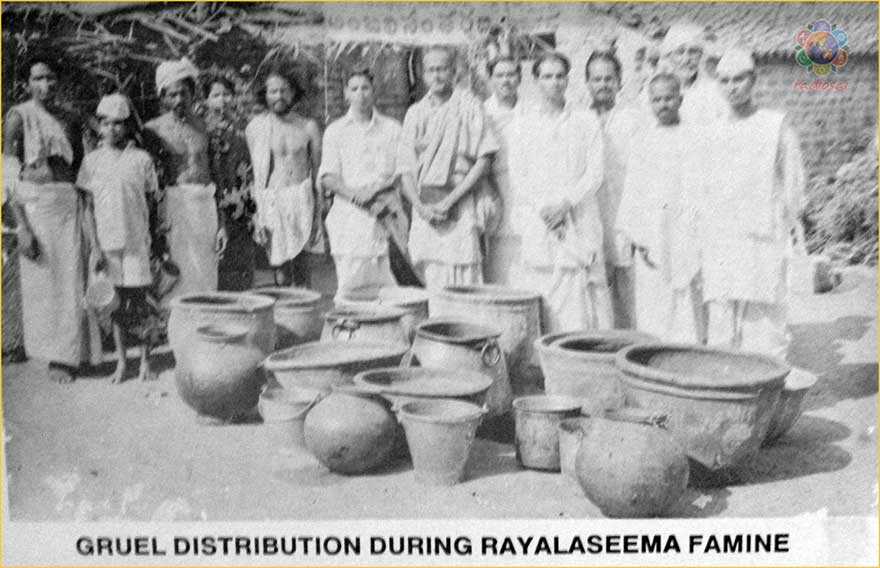 |
Reaching God through the world
Imagine the finger saying that it loves the body but it will not serve the hand. Foolish isn’t it? It is ignorance that prevents the finger from realizing that serving the hand also means serving the body. Swami clearly states that a person who says that he loves God but refuses to serve the society and creation is being as foolish.
Vyashti (individual) is a limb of Samashti (society) which in turn is a limb of Srishti (creation/nature). Srishti is part of Parameshti (God). That is why Swami exhorts,
“The best way to love God is to love all and serve all.”
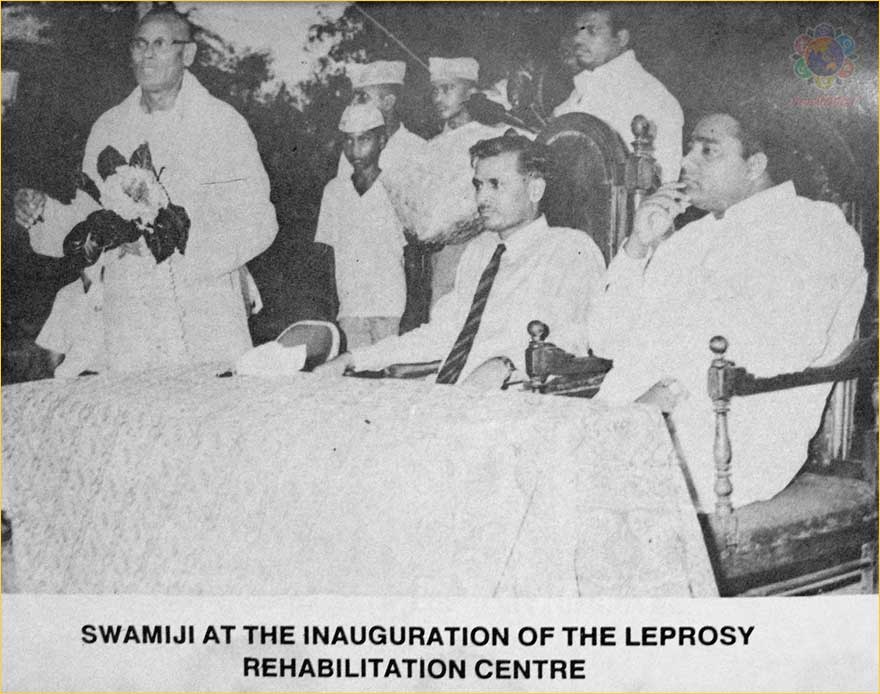 |
Karunyananda had spent six decades of his life serving individuals, the society and nature. He also interacted with the who's who of Indian society in the course of his work. He had been selfless in his intent and eager to progress spiritually. Though he had been conferred Sanyasa, he had the humility to heed to Gandhiji’s call and plunge into service of society. Every sinew in his body ached to serve his fellow beings - not just humans.
Karunyananda was responsible for stopping the animal sacrifices that went on at the famous Nakulamma temple at Samarlakota.
“All beings are children of Mother Earth; none will dare to eat his or her own children. How then will Goddess Nukalamma like to have her own children killed in front of her own shrine and offered in sacrifice?" he provoked their collective conscience.
In a nearby village of Yeleswaram, Swami Karunyananda's disciples went to the temple of Rupulamma and found animal sacrifice taking place on a large scale. Swami Karunyananda addressed the people at a special meeting for propagation of non-violence. The sacrifices ceased almost instantly!
Such had been his service towards society and nature that God decided to grant him the greatest gift - Himself. Once we see the way Karunyananda lead his life, it becomes a natural progression that Swami should walk to him that wonderful day at Rajahmundry and ask,
“Karunyananda, I am going to Kakinada. Would you like to come with Me?”
Soon, Karunyananda became a regular at Puttaparthi. He began to spend more and more time with Swami than with the organisation that he had built and nourished. On his part, Swami received him and allowed him to stay next to his own room in the Mandir. Later, he was allotted a room in South Prasanthi but he was granted the privilege to seek an audience with Swami whenever he wished! It is a beautiful experience to read his own words about these days.
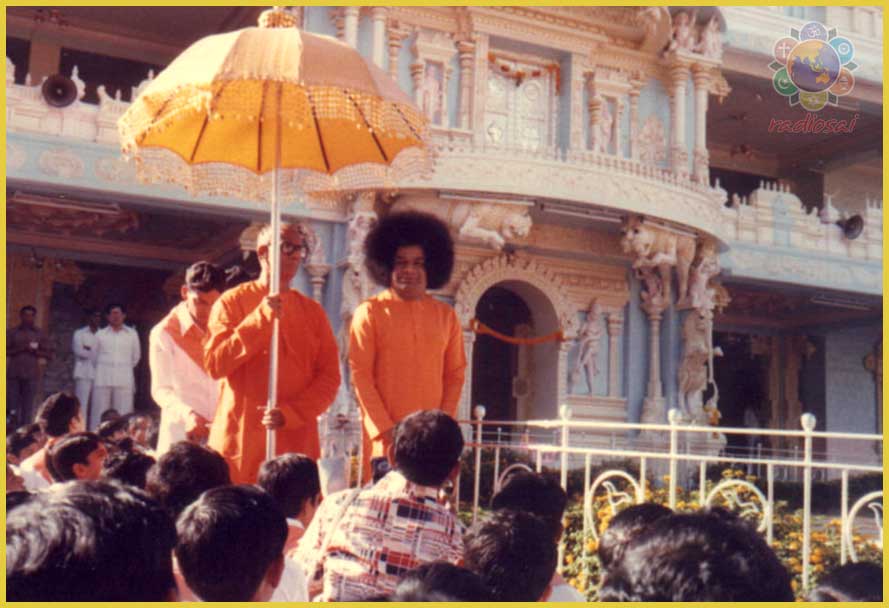 |
“I have the good fortune of being the first person to greet Bhagawan in the morning. I go upstairs, and open the door of Bhagawan's room and have darshan and padanamaskar of Bhagawan. There is Divine Power in the feet of Swami. There is power in the glances of Swami. His body is not like ours, it is a Chinmaya Sareeram (divine energy form). Ours is a body made up of dust, which dissolves finally, into the primordial elements of Earth, Water, Fire, Air, and Ether.
He is not limited to one form. He is the form of all deities worshipped by religions. He is the very embodiment of Chaitanya (energy, force). He is the embodiment of all Gods. We cannot probe into Him. Have you not seen Him during the mornings? He has a special effulgence in Him; sometimes this effulgence is frightening. On the last day of Devi Navaratri (Dasara) when Poorna Ahuti is performed, His body temperature becomes hot. I have touched His feet at such times and found that they were very hot.”
Later on, Karunyananda shut shop on the Sangam that he had started and settled down permanently in Prasanthi Nilayam till his last breath. Such a being is sure to have had several experiences with Swami. This part was meant to highlight the truth that service to society actually transforms into the opportunity to serve God! That being done, the icing on the cake - the experiences of Karunyananda with Baba - will be reserved for the next part.
- Aravind Balasubramanya
Radio Sai Team
| comments powered by Disqus |






